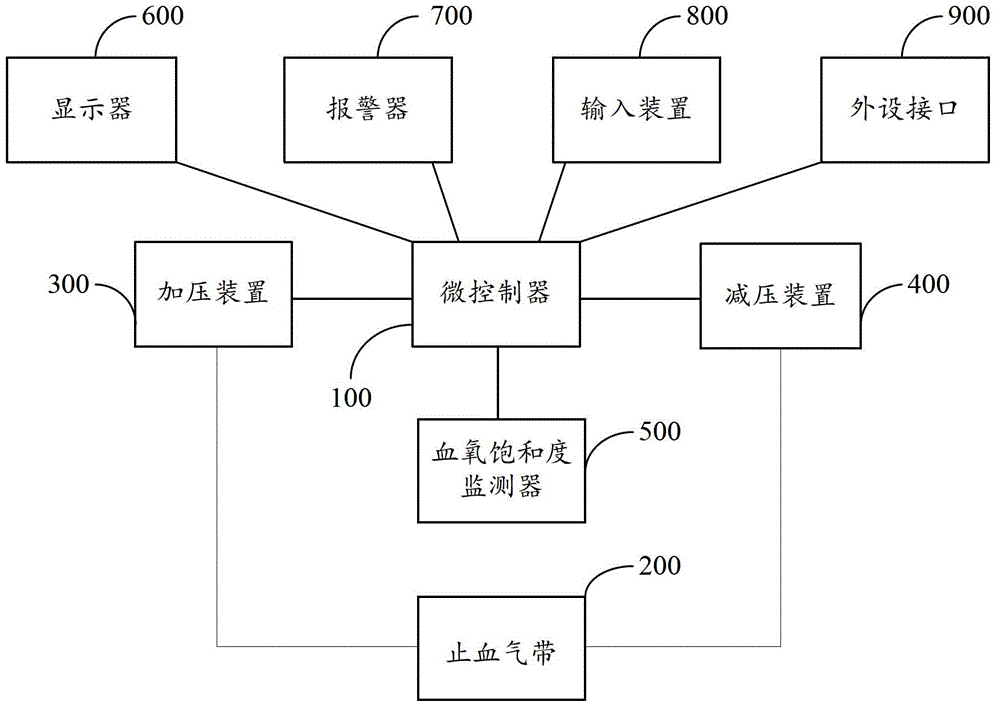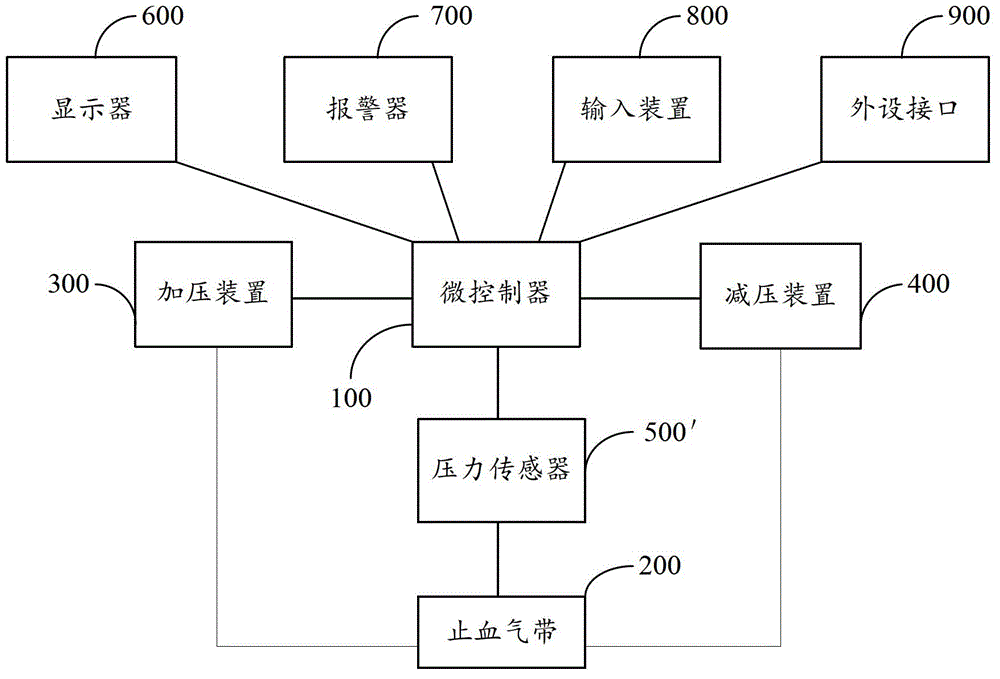First-aid instrument for crush injury
A crush injury and first aid instrument technology, applied in blood flow measurement, blood characterization device, tourniquet, etc., to reduce ischemia-reperfusion injury, avoid fatal injury, and prevent occurrence and development
- Summary
- Abstract
- Description
- Claims
- Application Information
AI Technical Summary
Problems solved by technology
Method used
Image
Examples
Embodiment 1
[0039] The structure of the squeeze injury first aid instrument of the present embodiment is as follows: figure 1 As shown, it mainly includes: a microcontroller 100, a tourniquet 200, a pressurizing device 300, a decompressing device 400, and a blood oxygen saturation monitor 500 for detecting blood flow.
[0040]The microcontroller 100 is connected to the pressurization device 300 , the decompression device 400 and the blood oxygen saturation monitor 500 . The tourniquet 200 is connected to the pressurizing device 300 and the decompressing device 400 . The tourniquet 200 is tied to the proximal end of the compressed limb, and the pressurizing device 300 and the decompression device 400 are respectively inflated and deflated under the control of the microcontroller 100 to prevent blood from flowing into the squeezed wound when inflated , When deflated, blood flows into the squeezed wound. The pressurizing device 300 is usually an air pump, and the depressurizing device is u...
Embodiment 2
[0051] The squeeze injury first aid instrument in the above-mentioned embodiment 1 requires that the extremities of the injured person are not injured. If the extremities are seriously injured (such as: severely damaged), the blood oxygen saturation cannot be monitored by the blood oxygen saturation monitor, thereby The blood flow information of the limb cannot be judged. Therefore, this embodiment uses a pressure sensor to detect blood flow information. The structure of the squeeze injury first aid instrument of the present embodiment is as follows: image 3 As shown, it mainly includes: a microcontroller 100, a tourniquet 200, a pressurizing device 300, a decompressing device 400, and a pressure sensor 500' for detecting blood flow.
[0052] The microcontroller 100 is connected to the pressurizing device 300, the decompressing device 400 and the pressure sensor 500'. The tourniquet 200 is connected to the pressurizing device 300, the decompressing device 400 and the pressu...
Embodiment 3
[0063] The structure of the squeeze injury first aid instrument of the present embodiment is as follows: Figure 4As shown, it includes: a microcontroller 100, a tourniquet 200, a pressurizing device 300, a decompressing device 400, a blood oxygen saturation monitor 500 and a pressure sensor 500'. Compared with Embodiments 1 and 2, it also includes: a blood oxygen saturation monitor 500 and a pressure sensor 500'. During first aid, if the injured person's extremities are not damaged, the blood oxygen saturation monitor 500 can be used to detect blood Streaming information, selection is selectable on the control panel of the microcontroller 100 through an input device.
[0064] The first aid device for crush injuries in this embodiment can realize the functions of Embodiment 1 and Embodiment 2 respectively, therefore, the process of realizing "ischemic post-treatment" will not be repeated here.
PUM
 Login to View More
Login to View More Abstract
Description
Claims
Application Information
 Login to View More
Login to View More - R&D
- Intellectual Property
- Life Sciences
- Materials
- Tech Scout
- Unparalleled Data Quality
- Higher Quality Content
- 60% Fewer Hallucinations
Browse by: Latest US Patents, China's latest patents, Technical Efficacy Thesaurus, Application Domain, Technology Topic, Popular Technical Reports.
© 2025 PatSnap. All rights reserved.Legal|Privacy policy|Modern Slavery Act Transparency Statement|Sitemap|About US| Contact US: help@patsnap.com



